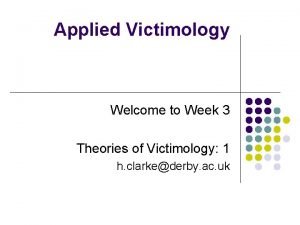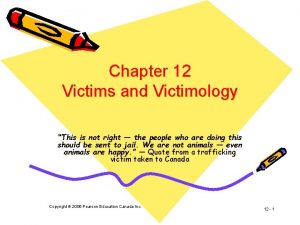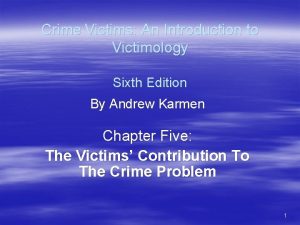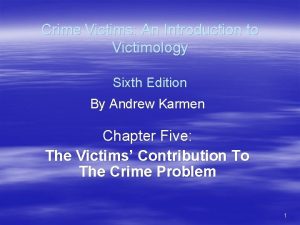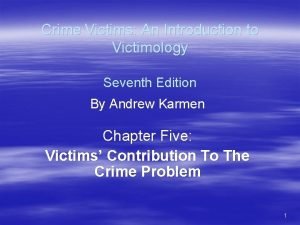Crime Victims An Introduction to Victimology Sixth Edition


















- Slides: 18

Crime Victims: An Introduction to Victimology Sixth Edition By Andrew Karmen Chapter Seven: Victims’ and the Criminal Justice System: Cooperation and Conflict, Part Two 1

Victims and Prosecutors § Prosecutors are chief law enforcement officer within the jurisdiction – How they can serve victims: § Keep informed of status of case § Support victims with judges, bail, continuances, negotiated pleas, dropped charges, sentences and restitution § Protect from harassment, threats, injuries and forms of intimidation and reprisals § Resolve as quickly as possible § Assist victims in recovering property from police 2

Victims and Prosecutors § Victim Witness Assistance Projects (VWAP) § To address witness and victim complaints § Intended to restore faith in CJ system – Personal intervention as soon as possible – Immediate relief to injured parties: § Hotlines, shelter, food, counseling, transportation and immediate lock repairs 3

Victims and Prosecutors § Protecting Victim Witnesses – Intimidation § Criminals, families and acquaintances of offenders, gangs, own family attempting to have victim drop charges—cultural issues— see Table 7. 1, page 158 § Prosecutor should offer victim: Protective services, phone number change, door locks, Orders of Protection, new home or relocate, Victim Witness-Protection Program 4

Victims and Prosecutors § VWAP Services – Recover lost property quickly – Provide information about reimbursement for losses and compensation benefits – Keep victims informed of case developments – 1974— 35% of DA offices routinely notified felony victims of case outcomes – 1992— 97% 5

Victims and Prosecutors § Dismissing or rejecting charges based on several issues: – Police officials, others in prosecutor’s office, defense attorneys, judges, community leaders, media, and vocal interest groups all affect prosecutor’s decision – 51% of all felony cases in 1981 not pursued – 45% of all felony cases in 1988 not pursued 6

Victims and Prosecutors § Negotiating Pleas – Defendant agrees to make confession for consideration – 95% of convictions secured by accused admitting guilt—oftentimes reduced from felony to misdemeanor In anticipation of the above, police and prosecutors engage in: Bedsheeting Overcharging 7

Victims and Prosecutors § Plea negotiations result in: – Reducing court caseloads – Preventing rape victims from testifying – Preventing children from testifying – Prosecutors often feel threatened by involvement of victims—revenge motive – Few jurisdictions provide defined role for victims – Victims may not challenge decisions of prosecutor 8

Victims and Defense Attorneys § Defense Attorney – Natural enemy to victim – Attempts to protract the process, discredit witnesses – Sixth Amendment guarantees a “Speedy Trial”—some states have time limits for trial after arrest – Efforts to delay wear down witnesses, affect memory of witnesses, find info about witnesses and victims – Eventually encourages witness to drop or reduce charges 9

Victims and Defense Attorneys § General Rule: The more serious the charge, the longer it takes to go to trial— 1988 Data: – Pleas guilty— 114 days arrest to sentencing – Trial— 241 days arrest to sentencing – Murder cases— 313 days; Rape cases— 133 days; Robbery cases— 108 days 10

Victims and Defense Attorneys § Sixth Amendment provides that defendants have the right to confront their accusers § Trials are relatively rare events § Due to competition between sides, courtroom tactics seem harsh and meanspirited – Cast aspersions on character of victim – Often trashes victim in controversial cases 11

Victims and Judges § Most conflict results during bail setting and sentencing § Eighth Amendment prohibits excessive bail § 2/3 of victims of serious crimes face the prospect that offender harming them will be out on bail prior to case being resolved § Denying of bail results in offender going to jail and being punished before conviction 12

Victims and Judges § Sentencing can be influenced by victims in two ways: – 1. Conveying their requests in writing to the judge – 2. Expressing their views orally in person at sentencing hearing (allocution) Victim Impact Statements (VIS) can provide valuable information to a judge Often included in a pre-sentence investigation and reviewed by judge prior to sentencing 13

Victims and Judges § U. S. Supreme Court ruled that VIS were not admissible in the penalty phase of a murder trial (Booth v. Maryland, 1987) § Court reversed itself in 1991, Payne v. Tennessee, stating VIS was admissible during penalty phase if execution was an option for a jury § Practice of using VIS not widespread for judges § See Box 7. 1, page 170 for more U. S. Supreme Court rulings regarding victims—majority of these decisions rejected victim arguments 14

Victims and Corrections Officials § Victims more likely to have contact with probation and parole agents than prison officials § Victims want three things from agents: – Know when offenders are off parole – Protected from harassment or harm – If court ordered restitution, want it on time § Corrections to keep victim advised of offender’s address—VINE System 15

Victims and Corrections Officials § Parole boards often recipient of criticism from both victims and victim groups – – – Typically opposed to “early release” Want to abolish Support determinate sentencing § Parole Boards to provide victims opportunity to appear at parole hearing—Very few victims take advantage § VIS is included in offender’s file for the parole board to review in making release decisions 16

“AND JUSTICE FOR ALL” § 14 th Amendment promises “equal protection under the law” § Is justice blind to all groups in the pursuit of justice? § Are all victims handled equally? § See Box 7. 2, page 175—Which Victims Get Better Treatment? § “Differential handling” needs to be researched again to see if Box 7. 2 data still persists today 17

Key Terms District Attorney Assistant District Attorney Consideration Plea Bargaining Plea Negotiations Cop a plea Bedsheeting Overcharging Sentence disparity Allocution Equal Protection under the law Blind Justice Differential Handling Second Class Treatment Red Carpet VIP Treatment 18
 Peter pickle tongue twister
Peter pickle tongue twister Rubber baby buggy bumpers tongue twister lyrics
Rubber baby buggy bumpers tongue twister lyrics Biochemistry sixth edition
Biochemistry sixth edition Computer architecture a quantitative approach sixth edition
Computer architecture a quantitative approach sixth edition Automotive technology sixth edition
Automotive technology sixth edition Automotive technology sixth edition
Automotive technology sixth edition Apa sixth edition
Apa sixth edition Computer architecture a quantitative approach 6th
Computer architecture a quantitative approach 6th Precalculus sixth edition
Precalculus sixth edition Principles of economics sixth edition
Principles of economics sixth edition Computer architecture a quantitative approach sixth edition
Computer architecture a quantitative approach sixth edition Dorothea puente victimology
Dorothea puente victimology Stephen schafer victimology
Stephen schafer victimology Theories of victimology
Theories of victimology Victimization theory
Victimization theory Differential risk victimology
Differential risk victimology Benjamin mendelsohn victimology
Benjamin mendelsohn victimology Makalah green victimology
Makalah green victimology Victimology in criminology
Victimology in criminology













